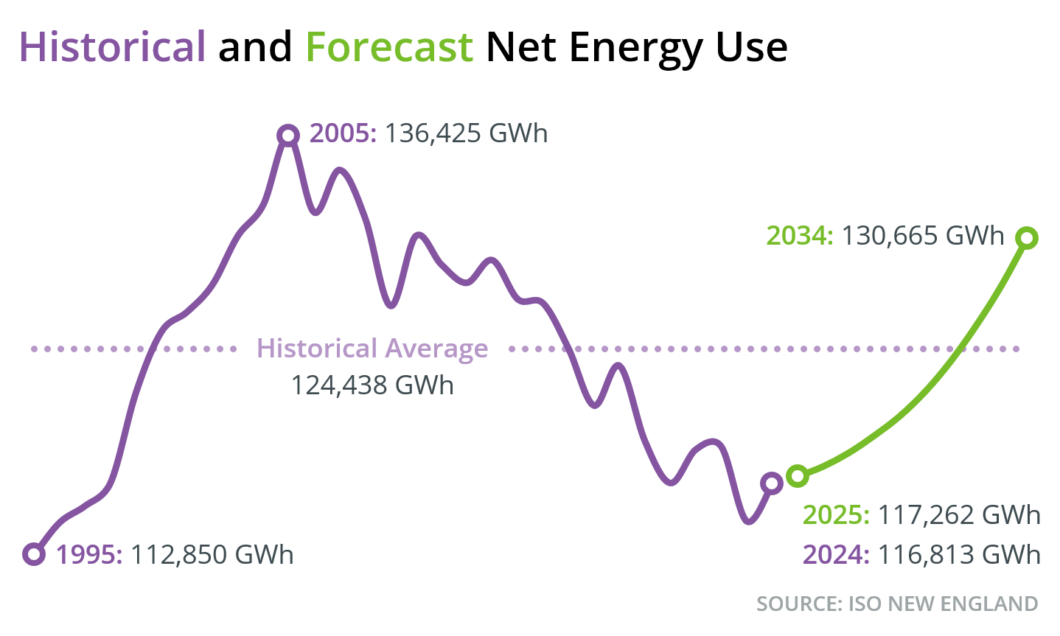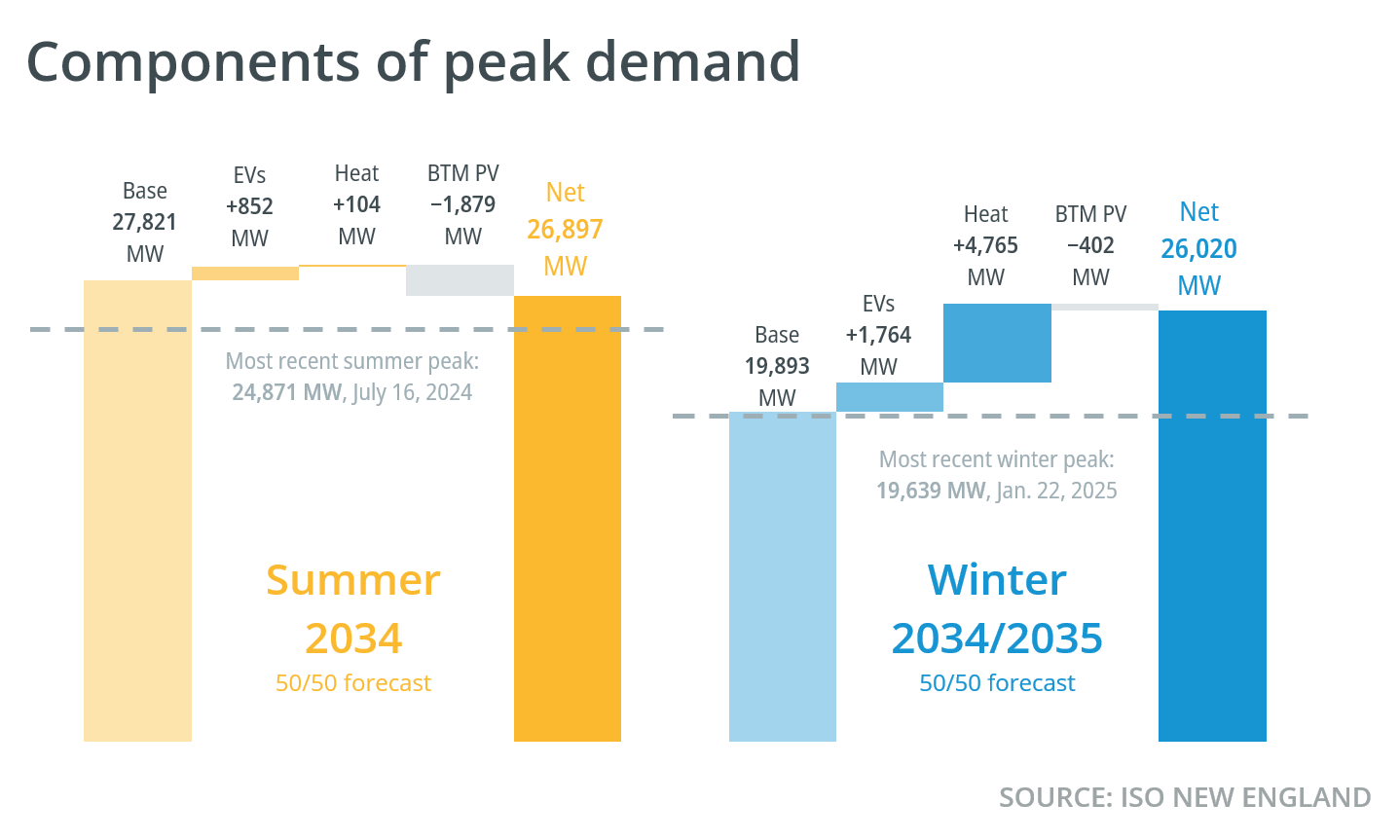Enhanced long-term forecast predicts steady growth in energy use, peak demand

A new report from ISO New England projects the region’s annual electricity consumption will increase by about 11% over the next decade, driven primarily by the electrification of heating systems and transportation.
Load forecasters at the ISO examined expected economic growth, historical weather patterns, projected adoption of technology like distributed solar photovoltaics (PV), electric vehicles (EVs) and air-source heat pumps, and state-level carbon reduction goals to develop the 2025–2034 Forecast Report of Capacity, Energy, Loads, and Transmission (2025 CELT Report), which serves as a foundational resource for the ISO’s system planning and reliability studies.
Components of the report include:
- A long-term forecast for energy consumption and peak demand that accounts for the impacts of electrification, behind-the-meter (BTM) PV generation, and energy efficiency
- The potential output of resources participating in the capacity market, as well as the total generating capability of resources in the region
- A breakdown of the region’s generators by fuel/unit classification
- A link to the listing of transmission projects proposed, planned, and under construction
Changes in regional electricity use since 1995
Net annual energy use in New England grew steadily between 1995 and 2005, driven primarily by increased economic growth and the use of air conditioning. Since 2005, net annual energy use has trended downward mainly due to an increase in energy efficiency from advanced cooling and heating technologies, energy-efficient appliances and lighting, and the increased prevalence of BTM PV generation. However, ISO New England is predicting that trend will reverse in the next decade. The ISO is forecasting steady growth in net annual energy use as state policy goals for carbon emissions reductions drive the increased electrification of heating systems and transportation in the region.

Improved input assumptions and methodology
The ISO’s innovative load forecasters continually refine their methods and assumptions to keep pace with emerging trends.
Since last year’s CELT Report, the ISO has implemented enhanced forecasting methods, including an hourly approach to more accurately account for evolving patterns of energy production and consumption. Previously the forecast relied primarily on annual energy and seasonal peak projections.
The level of geographic detail has increased as well. The base demand forecast is broken down into eight load zones, a smaller subset of New England’s six states. Projections related to distributed energy resources, heat pumps, and electric vehicles have been generated for each of the region’s 67 counties.
While energy consumption is expected to increase dramatically in the coming years, the enhanced methodology has yielded a lower overall energy use forecast than previous editions of the CELT. In particular, the transportation electrification forecast has been revised downward due to slower-than-expected EV adoption to date and uncertainty around incentive programs moving forward. Meanwhile, forecasts for peak demand — the periods of greatest electricity use — remain roughly in line with previous expectations.
New England electricity projections for 2025 to 2034
The energy and peak forecasts at the heart of the 2025 CELT Report have four key components:
- The base forecast is derived from historical demand patterns and expected future conditions. It includes the impact of energy efficiency programs.
- The heat pump forecast captures expected demand growth from electrification of the heating sector.
- The electric vehicle forecast captures expected demand growth from electrification of the transportation sector.
- The BTM PV forecast captures the expected impact of distributed energy resources, primarily behind-the-meter solar, that reduce demand for grid electricity.
The first three components make up the gross long-term forecast. Results of the BTM PV forecast are subtracted from the gross forecast to produce the net long-term forecast.

Overall electricity use in New England
| Total Annual Use (GWh) | 2025 | 2034 |
| Net Forecast | 117,262 | 130,665 |
- Net annual energy use is expected to grow by 1.2% annually over the 10-year period.
- BTM PV is projected to reduce consumption of grid electricity by 5,555 GWh this year, rising to 11,487 GWh in 2034.
- EVs are expected to account for 8,735 GWh of energy use in 2034, while heating electrification is expected to account for 8,049 GWh that year.

Seasonal peak demand
Peak demand is a measure of the highest amount of electricity used in a single hour, and the CELT Report includes forecasts for both summer and winter peaks. Traditionally, the expected annual peak in New England occurs during the summer. ISO New England analysts use historical data on typical peak weather conditions to develop the 50/50 forecast, reflecting a 50% chance that peak demand will be above or below the forecast. By 2034, ISO New England predicts the winter 50/50 net peak will nearly match the summer 50/50 net peak as the electrification of heating accelerates.
The 90/10 forecast—which reflects hotter, more humid peak conditions in the summer and colder temperatures in the winter—means there is a 10% chance that peak demand will be higher than the forecast.
| Summer Peak Demand (MW) | 2025 | 2034 |
| 50/50 Net Forecast | 24,803 | 26,897 |
| 90/10 Net Forecast | 25,886 | 28,297 |
- Under typical summer weather conditions, net peak demand is expected to rise at an annual rate of 0.9%. For hotter weather, the net peak is also expected to rise by 0.9% annually.
- BTM PV reduces the summer peak by an average of 1,870 megawatts (MW) in each year of the forecast. Although in past years the summer peak typically occurred in the afternoon, widespread adoption of BTM PV has effectively pushed the peak toward evening. This means that even as more BTM PV comes on line, its impact on summer peaks will not significantly increase.
- Transportation electrification is expected to contribute 852 MW to 50/50 summer peak demand in 2034.
| Winter Peak Demand (MW) | 2025/2026 | 2034/2035 |
| 50/50 Net Forecast | 20,056 | 26,020 |
| 90/10 Net Forecast | 21,125 | 28,714 |
- Under typical winter conditions, net peak demand is expected to rise by an average of 2.9% annually through the winter of 2034/2035. For colder weather, the net peak is expected to increase by 3.1% annually.
- Heating electrification is projected to contribute 4,765 MW to the 50/50 winter peak in 2034/2035.
- Transportation electrification is forecast to contribute 1,764 MW to the 50/50 winter peak in 2034/2035.
- BTM PV is forecast to have a growing impact on 50/50 winter peak demand, reducing it by 402 MW in 2034/2035. As a result of heating electrification, winter peaks are expected to begin shifting from evening, when BTM PV is inactive, to morning, when production from solar installations is beginning to ramp up.
Learn more about the 2025 CELT Report
- Categories
- Publications
- Tags
- CELT
